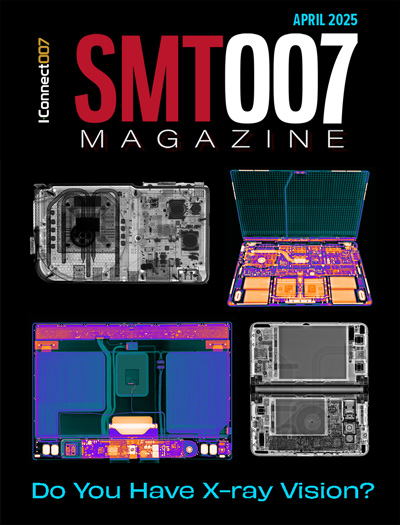-

- News
- Books
Featured Books
- smt007 Magazine
Latest Issues
Current Issue
Do You Have X-ray Vision?
Has X-ray’s time finally come in electronics manufacturing? Join us in this issue of SMT007 Magazine, where we answer this question and others to bring more efficiency to your bottom line.

IPC APEX EXPO 2025: A Preview
It’s that time again. If you’re going to Anaheim for IPC APEX EXPO 2025, we’ll see you there. In the meantime, consider this issue of SMT007 Magazine to be your golden ticket to planning the show.

Technical Resources
Key industry organizations–all with knowledge sharing as a part of their mission–share their technical repositories in this issue of SMT007 Magazine. Where can you find information critical to your work? Odds are, right here.
- Articles
- Columns
Search Console
- Links
- Media kit
||| MENU - smt007 Magazine
Detecting and Preventing Programmable IC Defects Prior to Placement
December 31, 1969 |Estimated reading time: 5 minutes
Testing of programmable integrated circuits (IC) does not occur until in-circuit test (ICT) in many cases. If a device is defective, it is already soldered on the board, which must be reworked or scrapped. If these functional defects can be detected prior to placement, yield and profits will go up.
Whenever a failed board is identified on an SMT line, the failure analysis process dictates that the cause of the fault must be determined and the defect eliminated. Inspection and testing is built into the line to detect faults and minimize defects. The earlier in the process the fault is detected, the better chance of finding the defect and improving yield. Each line operation adds to the complexity of the failure analysis, as well as the cost of detecting and correcting the defect.
The defect could be difficult to detect without a functional test of the board. Because ICT happens near the end of the line, this is where there is the most opportunity to lower costs. While board assembly and placement errors can be detected by inspection, faults internal to an EEPROM, microcontroller or other programmable IC cannot.
 Cost of correcting faults during the manufacturing process.
Cost of correcting faults during the manufacturing process.
Most component failures are due to external forces. A device can be damaged by internal lot-sensitive defects and external packaging or handling defects. The manufacturer functionally tests ICs prior to packaging; however, some qualification tests impart stresses of varying extents on the packages.
As new processes are developed, devices can become even more susceptible. It is important to detect the fault early in the process for the largest cost reduction (Figure). Reducing scrap and rework costs is accomplished by improving yield.
Internal defects may not be detected until there is an electrical failure at ICT.¹ However, most internal device defects can be detected by programming and verifying the device prior to placing it on the board.
Why are there internal defects? The answer is improper device handling — humidity and temperature — at any place the devices are exposed. Defects also can be caused by vibration or other mechanical disturbances, such as dropping a tray of parts on the ground. Defects caused by external forces include:
- Moisture penetration
- Mechanical stress cracks
- Improper bonding
- Crystal defects
- Fabrication faults.
X-ray can detect many of these defects; however, there is a chance for escapes that will not be identified until ICT.
Defects detected by X-ray include:
- Poor bonding interfaces — These may not be readily detectible during initial screening and testing.
- Wire sweep — This results in wire bonds that are pushed close to or touching other wires or the die edge, shorting the device.
- Voids in the die attach.
- Voids in the molding compound.
Programming Prior To Placement
The main benefit of programming prior to placement is to identify defects earlier.
A secondary benefit is the improved yield that results from verifying data on another independent programming and test site. This cross-verification adds to the testing plan.
Today's device programming software allows for programming and verification of the programmable areas of the chip, as well as vector testing when possible. This will not detect defects that occur after the programmable devices are placed on the board, but will keep defective devices from being placed. The costs of detecting and correcting a defect generally are just the cost of a single scrapped device.
When programming times were 1 to 5 seconds per board, in-circuit programming could be done at almost no cost. However, with demand for high-density Flash and Micros, programming times now can be 60 to 120 seconds or more.
Manually programmed devices are subject to bent leads and other contamination from operators, including ESD. Automated device handling reduces potential lead damage. Fine-pitch automated programming systems use the same centering and motion control systems used on the SMT line. Therefore, the chance for damage is minimal, and damaged devices can be detected.
Manual operation relies on the operator to verify that only properly programmed devices are placed in the finished tray. However, the operator can become distracted and lose focus.
Centers that rely on manual programming stations often wind up with blank devices delivered to the SMT line. Blank parts are put into the tray because the operator became distracted and could not tell if the device was programmed or not. A manual device programmer that does not have a way to tell if the part in the socket has been programmed is asking for trouble.
The best way to avoid potential handling defects is to use an automated device handler. If manual programming is necessary train operators in proper handling, and find a programmer that indicates whether the part in the socket already has been programmed.
Programming Off-line
Programming devices off-line takes less time than programming at test, with no algos to write. Outsourcing firms can provide first articles for popular devices within a week, and production orders can be completed and shipped overnight as needed.
Costs generally depend on IC complexity and density, as well as production volume requirements. In most cases, it is less expensive to program off-line than to use more time on testers. This is especially true for high-density devices.
For example, a distribution center or third-party programming house could program the IC. A small Flash EEPROM may cost 25 cents or less to program, compared to the cost per board to program the same device on the tester.
Programming devices in-house also may be considered if volumes are large enough, or if sensitive data must be protected. Automated programming solutions use the same vision and placement systems as other pick-and-place equipment, so operators and technicians are well equipped to use these machines. Using only one shift, a single operator could program 1 million devices per year with up to a 60-second programming time for less than 7 cents each.
Conclusion
Programming before placement, combined with automated device handling during programming, can detect functional defects, reducing the amount of scrap and rework.
Reference
¹ Adams, Tom, "Automated AMI Analysis of Components Prior to Board Assembly," SMT Magazine, September 2003, p. 56.
Kevin Corken, product manager for Automated Programming Systems for BP Microsystems, may be contacted at 1000 N. Post Oak, Suite 225, Houston, TX 77055; (713) 688-4600; E-mail Kevin_Corken@bpmicro.com; Web site: www.bpmicro.com.


